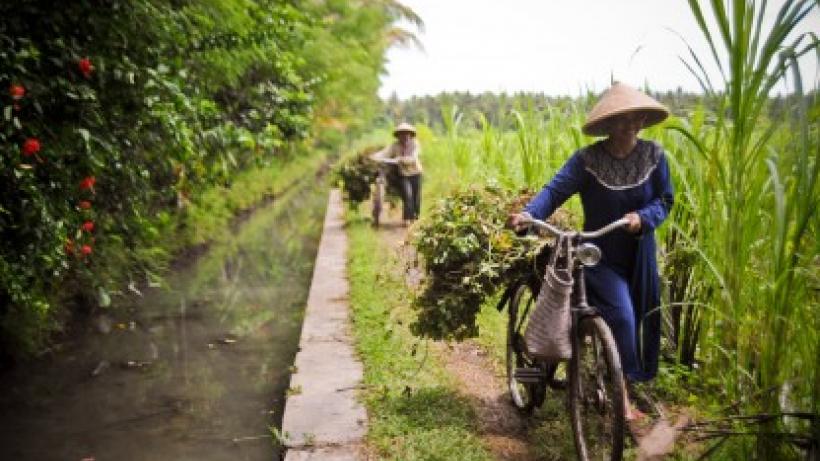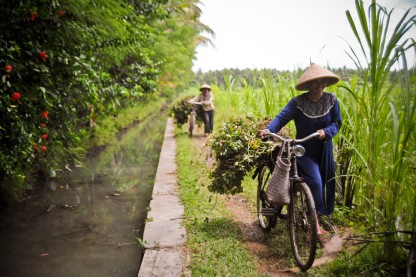
Matching and migration: Lessons from a resettlement programme in Indonesia
The success of rural relocation and resettlement programmes may be dependent on the transferability of migrants' skills and experiences to their destinations. New findings from an Indonesian study suggest that relocation programmes should consider providing agricultural extension services to ensure migrants adapt and cope in new environments.
Forced migration due to climate change, natural disasters, or conflict may be one of the most important policy challenges of the 21st century. Myers (2005) argues that as higher temperatures lead to rising sea levels, coastal flooding, droughts, and new rainfall patterns, these changes could displace nearly 200 million people by 2050. In South Asia alone, extreme weather events are expected to uproot over 60 million people (Stern, 2007). War also continues to displace populations. The conflict in Syria has already produced more than 9 million refugees and is expected to produce even more.
 Farmers transporting crops beside an irrigation canal.[/caption]
Farmers transporting crops beside an irrigation canal.[/caption]
Image credit: Asian Development Bank
While income transfers are a first best solution to compensate victims of natural disasters or conflict, the poor state of land and housing markets in many developing countries often makes cash-based solutions difficult to implement. As an alternative, some governments are considering rural-to-rural resettlement programmes. Displaced migrants are given new farmland and housing in newly developed areas. For such programmes to be effective, they need to be well-designed, and adapted to suit the needs of poor rural households, where rain-fed agriculture remains a major source of subsistence.
Matching matters
A well-designed resettlement programme would allow settlers to optimise long-run productivity in a new environment. However, in designing these programmes, a crucial question is whether skills acquired in one environment are readily transferrable to economic activities in another environment. If skills are not transferable, then policymakers may need to play an active role as matchmakers. Information on settlers’ skills at their origin should be used to match settlers based on environmental needs identified at their destination.
Resettlement programmes need to be coupled with effective agricultural extension services that can train farmers in managing crops in their new environments.
However, it is difficult to identify barriers to skill transferability because voluntary migrants tend to choose locations where they expect their skills to be most transferable. Migrants have been selecting favorable locations for millennia; for instance, Steckel (1983) and Diamond (1997) document a tendency for migrants to move from east to west, rather than from north to south, as they settled the agricultural frontier, suggesting the important role of soil and climate conditions in determining migrant destinations. Observational data are, therefore, of limited value in identifying the importance of skill transferability in shaping productivity.
In Bazzi et al. (2015), we use a natural experiment—Indonesia’s largest resettlement programme, known as the Transmigration Program—to measure barriers to skill transferability. Between 1979 and 1988, the government of Indonesia relocated nearly 2 million voluntary migrants from rural areas in Java and Bali to rural areas in the Outer Islands, to reduce population pressures and stimulate agricultural production (see Figure 1). Transmigrant households were given free transport to newly created settlements. Upon arrival, they received free housing, a two-hectare plot of farmland (allocated by lottery), and provisions for the first few growing seasons, including seeds, tools, and food.[1]
Figure 1: Map of transmigration villages
 Source: Bazzi et al., 2015
Source: Bazzi et al., 2015
Due to various constraints and an ad hoc, “plan-as-you-proceed” approach to implementation (World Bank, 1988), transmigrants experienced as-if random assignments to destinations. Some transmigrants were sent to similar locations in the Outer Islands, while others were sent to very different farming environments- they had no say in their ultimate destinations. The unprecedented spatial scope of the programme, with destination villages scattered across the Outer Islands, meant that migrants from diverse origins across Java/Bali were observed across a range of new agroclimatic conditions at their destinations. This gave rise to plausibly exogenous (and wide-ranging) variation in the assignment of migrants to destinations, which allows us to identify the causal effect of skill transferability on productivity.
We use geospatial data on agricultural and climatic conditions to construct an agroclimatic similarity index that measures the similarity in the farming environment between a migrant’s origin and her destination. Given the as-if random assignment of transmigrants, the coefficient of this similarity measure in an agricultural productivity regression identifies the causal effect of skill transferability on migrants’ productivity.
We find that skill transferability has large effects on village-level rice productivity. Rice was the focal crop of the programme and is a primary staple, both for Indonesia and more than half of world. Our estimates imply that, on average, an increase in agroclimatic similarity by one standard deviation leads to a 20% increase in village-level rice productivity. This translates to an additional 0.5 tons per hectare—an effect size roughly equivalent to twice the productivity gap between farmers with no schooling versus those that have completed junior secondary.
Where matching matters more
Interestingly, we also find that the relationship between skill transferability and productivity is nonlinear. Semiparametric specifications (Figure 2) reveal that villages whose migrants are from the most dissimilar origins face the largest productivity losses. These results suggest that resettlement planners should try to match migrants to similar destination environments to the extent possible, and they should be particularly concerned about minimising bad matches. We provide simulation evidence to suggest that a more optimal assignment of transmigrants would have increased aggregate rice production by 27%.
Figure 2: Nonlinear relationship between village-level agroclimatic similarity and rice productivity

Source: Bazzi et al. (2015).
Note: This figure shows a steep relationship between agroclimatic similarity and productivity for low levels of similarity, which tapers off at higher levels of similarity. The reversal in the left tail is not uniformly robust (it depends in part on the choice of bandwidth in estimating this relationship), but it may reflect the role of social capital. For example, villages with very low similarity could be low because everyone is from the same district and is badly matched to a new environment. Increasing similarity would necessitate bringing in people from diverse origins, which could undermine social capital and reduce productivity.
Policy implications
Although matching resettled populations to destinations is a good way to ensure that migrants remain productive, other coping mechanisms are possible. While many food crops seem to also be sensitive to agroclimatic similarity, other crops, such as cash crops, seem to be less sensitive to growing conditions and may be an alternative for farmers who face unfamiliar growing conditions. Moreover, consistent with agronomic literature on the complexities of soil management (De Datta, 1981), barriers to transferability appear to be greatest for soil-specific knowledge. Resettlement programmes need to be coupled with effective agricultural extension services that can train farmers in managing crops in their new environments.
One lesson from the programme has broader implications for resettling diverse migrant populations. We find that migrants whose native language is similar to the local indigenous language in the Outer Islands are more likely to switch into trading and services occupations. Beyond highlighting the importance of careful matching in allocating migrants across destinations, this finding also suggests that language training can help facilitate adaptation. In follow-up work, we further investigate the role of language in building social capital and interethnic cooperation within the new settlements.
Resettlement programmes are logistically challenging and expensive. Moreover, the land clearing associated with resettlement programmes can be environmentally damaging, resulting in deforestation that could lead to even greater greenhouse gas emissions—exacerbating the problem that they were trying to solve.[2] Nevertheless, with careful planning, resettlement remains a feasible and politically attractive option for coping with environmentally-induced migration in many settings. The lessons from Indonesia’s Transmigration programme should help inform ongoing resettlement planning.
Footnotes:
[1] Journey to a New Life: The Human Face of Indonesia (1984) is a short film about the Transmigration Program that follows a family moving from East Java to Southeast Kalimantan. You can watch it here.
[2] For instance, Fearnside (1997) argues that the Transmigration program was an important source of deforestation in Indonesia, particularly in peat forest areas, which led to substantial greenhouse gas emissions.

